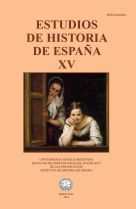Please use this identifier to cite or link to this item:
https://repositorio.uca.edu.ar/handle/123456789/7048| Título: | El códice como entidad unitaria : apuntes para la edición crítica del manuscrito 431 de la Biblioteca Nacional de Madrid | Autor: | Soler Bistué, Maximiliano | Palabras clave: | ECDOTICA; SEMIOTICA; HISTORICIDAD; DIPLOMATICA; CODICES; BIBLIOTECA NACIONAL | Fecha de publicación: | 2013 | Editorial: | Pontificia Universidad Católica Argentina. Facultad de Ciencias Sociales, Políticas y de la Comunicación. Instituto de Historia de España | Cita: | Soler Bistué, Ma. El códice como entidad unitaria : apuntes para la edición crítica del manuscrito 431 de la Biblioteca Nacional de Madrid [en línea]. Estudios de Historia de España. 2013, 15 Disponible en: https://repositorio.uca.edu.ar/handle/123456789/7048 | Resumen: | Resumen: El manuscrito 431 de la Biblioteca Nacional de Madrid fue compuesto hacia 1360, al calor de la Guerra Civil que enfrentó a Pedro I y Enrique II. Este códice constituye uno de los mayores testimonios de un intento de formalización escrita, a mediados del siglo XIV, del derecho señorial nunca fi jado ofi cialmente en Castilla. Los textos allí contenidos nunca fueron considerados como una unidad y por lo tanto fueron siempre editados y estudiados separadamente. El artículo se propone identifi car pautas formales que permitan establecer la entidad unitaria basándose no sólo en sus aspectos físicos (tipo de letra, materiales utilizados, lengua, etc.) sino también en líneas internas de signifi cación tanto en el plano sintagmático (relaciones de contigüidad in praesentia) como en el paradigmático (asociaciones que organizan patrones de lectura). Abstract: The manuscript 431 of the National Library of Madrid was composed around 1360, in the heat of the Civil War that pitted Pedro I and Henry II. This codex composed in the mid-fourteenth century is one of the greatest testimonies of an attempt to formalize seigneurial law Castilla never officially established. The texts contained therein were never considered as a unit and therefore were always edited and studied separately. The paper aims to identify formal guidelines that establish the unitary entity based not only on its physical aspects (fonts, materials, language, etc.) but also on internal lines of signifi cance at both syntagmatic (contiguity relations in praesentia) and the paradigmatic aspects (associations organizing reading patterns). |
Cobertura Espacial: | ESPAÑA | URI: | https://repositorio.uca.edu.ar/handle/123456789/7048 | ISSN: | 0328-0284 2469-0961 (online) |
Disciplina: | HISTORIA | Derechos: | Acceso Abierto | Fuente: | Estudios de Historia de España. 2013, 15 |
| Appears in Collections: | EHE - 2013 vol. 15 |
Files in This Item:
| File | Description | Size | Format | |
|---|---|---|---|---|
| codice-como-entidad-unitaria.pdf | 279,75 kB | Adobe PDF |  View/Open |
Page view(s)
118
checked on Apr 30, 2024
Download(s)
58
checked on Apr 30, 2024
Google ScholarTM
Check
This item is licensed under a Creative Commons License

